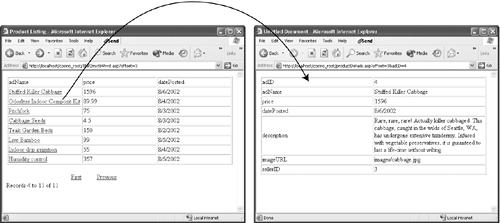Master Detail Page Set
A common task when building a database-driven Web site is providing your visitors with both an overview and detailed view of information. Usually, it takes two separate Web pages to do the job: one that lists limited information about all records in a recordset, and one which provides links to a page with detailed information about a single record. Dreamweaver calls these master and detail pages, and provides a tool for making quick work of this task (see Figure 22-15).

Figure 22-15. An example of Dreamweaver’s Master Detail Page Set. The screen on the left represents a master page—a list of items retrieved from a recordset. Clicking a link on this page opens a detail page (right), which displays the details of a single record.
The Master Detail Page Set object automates the process of creating dynamic tables and recordset navigation bars, as well as adding many different server behaviors to your pages. In fact, there’s nothing this tool does that you can’t do (albeit more slowly) with the other tools you’ve learned in this chapter.
Note
The Master Detail Page Set object is not available for either the ASP.NET or PHP/MySQL server models.
To create a Master Detail Page set, follow these steps:
Create two Web pages—one for the master page and another for the detail page.
They can be new, blank pages, or existing pages that just require the dynamic information from ...
Get Dreamweaver MX: The Missing Manual now with the O’Reilly learning platform.
O’Reilly members experience books, live events, courses curated by job role, and more from O’Reilly and nearly 200 top publishers.

